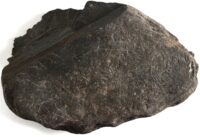 A stone engraved with multiple animal figures in the Upper Paleolithic era has been unearthed at the prehistoric Coves del Fem near Ulldemolins, Catalonia, northeastern Spain. About 15,000 to 11,700 years old, the stone is intricately carved with at least six animals: a doe, a stag, two goats or bovids and two others as yet undetermined.
A stone engraved with multiple animal figures in the Upper Paleolithic era has been unearthed at the prehistoric Coves del Fem near Ulldemolins, Catalonia, northeastern Spain. About 15,000 to 11,700 years old, the stone is intricately carved with at least six animals: a doe, a stag, two goats or bovids and two others as yet undetermined.
The plaque was discovered last summer during archaeological salvage in the wake of flooding. It is oval, about seven inches long and five wide and was engraved using a very sharp flint. The artist or artists were able to create impressive detail with the flint. Anatomical details like eyes, ears, noses, horns and fur are visible. The stag’s antlers are particularly impressive with their seven points.
The piece was among stone blocks found on the surface of the site after the floods eroded the strata. Researchers were examining the blocks because the prehistoric inhabitants of Coves del Fem used rocks and slates to make tools. They didn’t engrave them with art, however, so this stone came as a surprise.
Without a stratigraphic context, the engraving can only be dated by its style. The composition and execution compare to similar pieces found at other Paleolithic sites that do have well-established stratigraphic and absolute dates. The use of the cave to make tools took place long after the plaque was carved, between 6,000 and 4,500 B.C.
Its origin is still unclear but there are different theories about its presence in that area. “The river might have moved old remains and moved them to other, younger sectors,” she said adding that it was also possible that “maybe the younger communities, whose members tended to dig holes in order to keep their belongings there, touched older levels and moved that piece to their place.”
The piece is important as it appears to reference the ideological world of a community of hunters and collectors when engravings were symbolic representations. “It is known as ‘moving art’, it was not used to hunt or produce food, it is linked with the ideological world, with a way of ideological communication, but we do not know what it means,” the professor said.
She added that it might have been used to share rules with the rest of the community, or even to symbolize the tribe or the community. “What we do know is that for them, it had meaning and this meaning was shared with other individuals.”
Paleolithic art of this kind is very rare in Catalonia, which gives the piece oversized significance in the study of the Stone Age in the region. It also expands the known human occupation of the Monstant massif through the end of the Upper Paleolithic.
The piece is briefly on display at the Archaeological Museum of Catalonia from December 14th through January 24th. After that, researchers will continue to study it.